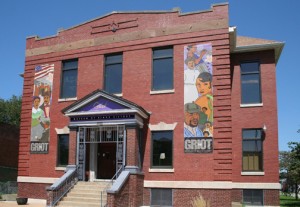
Image by Maureen Kavanaugh (stltourguide.wordpress.com)
Because Aki and I are working with a partner who is not based in Boston, geography will determine the listening practices we will be able to employ. We’re trying to be creative – what listening practices can we employ when we are not on the ground with our partner? For our work we are hoping to learn more about some of Lois’s (our main representative from the partner institution) processes around fundraising and audience outreach, as well as determine more information about her network as it relates to fundraising, new audiences, and the two new developments that are slated for The Griot’s neighborhood.
Similar to Aki, believe that an activity analysis will be particularly important to dig deeper into Lois’ processes. She is nearly a one-woman shop who covers most of the tasks related to the museum. Similarly, focusing on flow analysis will also allow us to pin down how Lois’ activities connect, and may reveal opportunities within her processes. Some of these processes will give us better insight into what Lois has already tried, as well as roadblocks and areas less traveled.
For some elements of our initial co-research, I think it will be helpful to envision what future activities could look like–a realistic future with all of its potential snags, as well as an ideal future in which The Griot and Lois are thriving in the manner they would like. For this type of research I think the listening practice of journey mapping and role playing could be interesting, and I think both can be done over the phone/video chat. Journey mapping may be a helpful next step to activity and flow analyses and allow Lois and our design team to imagine more ideal processes. Role playing could allow for us to better understand how other key stakeholders, partners or users might engage with some of our design ideas, but also how Lois might disrupt processes that she is currently a part of and wants to change.
This week, because Aki and I were both out of the country, we completed a set of follow-up questions over email with Lois. The week prior we drafted a set of questions we wanted ask Lois. We began the conversation sharing a little about who Aki & I both are and what we are hoping to get out of the partnership. I think this set an honest and personable foundation for the codesign relationship. We sorted our interview questions for Lois into categories with sub-questions. We then traded off asking questions and then taking notes while on the call to make sure Lois understands that Aki and I are in true partnership, even though my relationship with her preceded the project.
I have been thinking the breadth of epistemologies and methods of communication that can be present in this partnership, and wondering if in listening practices are best selected to honor the subjects at hand, the preferences of the co designing partner, the preferences of the designer, or some sort of calculation of all of the above. At present, I believe Aki and I are navigating with the subjects as our guiding force. For example, if we need to learn more about how Lois fundraisers, we will undergo an activity analysis; however, perhaps later in the process as we begin to understand our partner more and vice versa, perhaps our listening strategies would evolve instead of meet the needs of our partners preferred ways of knowing or methods of communication.
Lastly, an additional part of our listening practice will be listening to what stories and voices haven’t we heard from, and who can help to build our richer understanding of the issues Lois wants to address through our partnership.